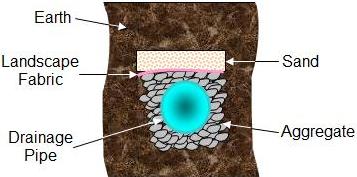Why This is Happening to You
Is your yard flooded while your neighbor’s yard is just fine? There are several reasons this may be happening. The two biggest factors are your lawn’s soil content and its lack of contour. When water enters your lawn it sinks into the soil and displaces the air, pushing it up. Heavy, compacted clay may contain a significantly less amount of air to displace, causing water to crest above the surface of your lawn much more easily.
In addition to the soil content, the contours of your lawn may be causing poor drainage. If your neighbor’s lawn is above yours, their rainwater may be draining into your lawn. If you have a mostly level lawn, that water just sits there because there’s nowhere to run downhill to. Every time you get a heavy rain, your lawn turns into a swamp.
Voilà the French drain
Installing a French drain is a little more complicated than digging a ditch and laying down pipe, but not much. You need to make sure you have a consistent slope for the drain to work. You need to make sure you lay down washed gravel underneath and above the pipe.
The complicated part isn’t the installation work; it’s knowing where to dig the ditch to make sure the drain is effective. You should start at the highest point of your lawn and run the trench down to the lowest point. It’s important to know that this type of trench drain won’t protect your foundation. A linear drain that acts like a moat may need to be installed around your foundation. Depending on how level your lawn is, a series of trenches may need to be dug to effectively drain your lawn.
Ideally, your trench drain should extend to a lightly used area of your lawn that has a more sand-based soil. You should also make sure that your drain is not designed to run all your water off into your neighbor’s lawn. With decades of experience in all sorts of drain installation, McMahon Plumbing can help you design and install the best system to keep your lawn dry!
